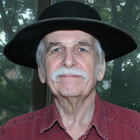Dr. Robert H. Webb
The New York Times article From a Poet’s Failing Sight, a Novel ‘Seeing Machine’ Emerges said
“Elizabeth Goldring’s eyesight has come and gone over the years. Mostly, it has gone. Now 61, she has had juvenile diabetes since college, and the disease has pecked away at her vision, causing hemorrhages in her retinas, the fragile layer of light-sensitive cells at the back of the eye.About 10 years ago, when she was nearly blind in both eyes, her doctor recommended a test to find out whether she had any healthy retina left at all. The test involved a large $100,000 machine called a scanning laser ophthalmoscope, which would let the doctor examine her retinas and project images directly onto them. If there were any live spots, the device might let her see.
It worked. She saw a stick-figure turtle. Ms. Goldring, a poet who has had three books published, asked to see a word. She was able to read ‘sun’. It was the first word she had seen in many months.
‘For a poet, that’s an incredible feeling’, she said. ‘I said almost immediately, ‘I need to get in touch with the man who invented this machine.’’”
Dr. Robert H. Webb, ScD (Honoris Causa) is the inventor of this machine and is Senior Scientist, Schepens Eye Research Institute and Wellman Center for Photomedicine at Massachusetts General Hospital and is Associate Professor, Departments of Ophthalmology and Dermatology, Harvard Medical School.
Rob is an inventor — primarily of diagnostic medical instrumentation. His current specialization is in new forms of confocal microscopy, but he also maintains a continuing involvement with earlier work in ophthalmic optics and flow cytometry. He designed the flow system and optics of one of the early flow cytometers, and these are in use throughout much of the field now. His first confocal microscope was the scanning laser ophthalmoscope, which he invented and developed in the early 1980s. There are over 300 papers yearly based on use of this instrument. His current research includes use of high brightness light emitting diodes for visual psychophysics displays and new microscopy. He is also collaborating on a scanning laser ophthalmoscope for mice that will use adaptive optics to make retinal cells visible non-invasively.
He is inventor or coinventor of 30 patents including Confocal microscopy with multi-spectral encoding and system and apparatus for spectroscopically encoded confocal microscopy, Optical confocal device having a common light directing means Apparatus for near simultaneous observation of directly scattered image field and multiply scattered image field, Method and apparatus for measurement and correction of optical aberration, Imaging apparatus and methods for near simultaneous observation of directly scattered light and multiply scattered light, Fiber-coupled multiplexed confocal microscope, and Confocal microscopy with multi-spectral encoding and system and apparatus for spectroscopically encoded confocal microscopy.
Rob authored Elementary Wave Optics in 1969 which was reprinted last year by Dover, and coauthored Optical characterization of ultrabright LEDs in Applied Optics, Wide-field retinal hemodynamic imaging with the tracking scanning laser ophthalmoscope in Optics Express, Using InterWave aberrometry to measure and improve the quality of vision in LASIK surgery in Ophthalmology, and Analysis of spherical aberration of a water immersion objective: application to specimens with refractive indices 1.33–1.40 in Journal of Microscopy. Read his full list of publications!
Rob earned a B.A. in Physics from Harvard University in 1955 and a Ph.D. in Physics from Rutgers University in 1959. He did postdoctoral training in Molecular Physics at Stanford University from 1959 to 1962. He received a Doctor of Science (ScD), honoris causa, from SUNY College of Optometry in 2003 and the 1999 Edwin H. Land Medal from the Optical Society of America and the Society for Imaging Science and Technology.
